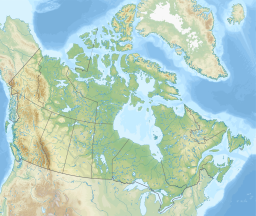geo.wikisort.org - Reservoir
Pike Lake[1] is an oxbow lake of the South Saskatchewan River in the Canadian province of Saskatchewan. It is about 36 kilometres (22 mi) south of downtown Saskatoon in the RM of Vanscoy No. 345, 2.5 kilometres (1.6 mi) west of the South Saskatchewan River. The lake is in the aspen parkland transitional biome between prairie and boreal forest in Palliser's Triangle.
| Pike Lake | |
|---|---|
 Pike Lake | |
| Location | RM of Vanscoy No. 345, |
| Coordinates | 51.9000°N 106.8173°W |
| Type | Oxbow lake |
| Catchment area | South Saskatchewan River |
| Basin countries | |
| Max. length | 4 km (2.5 mi) |
| Surface area | 258.79 ha (639.5 acres) |
| Max. depth | 2.5 m (8 ft 2 in) |
| Shore length1 | 20.66 km (12.84 mi) |
| Surface elevation | 478 m (1,568 ft) |
| Settlements | Pike Lake |
| 1 Shore length is not a well-defined measure. | |
Most of the southern half of Pine Lake is in Pike Lake Provincial Park[2] and access to the lake is from Highways 60 and 766. An unincorporated rural residential community by the same name, Pike Lake, is located on the western shore at the northern boundary of Pike Lake Provincial Park. The community includes a school and a recreation centre. Trees around the lake include aspen, ash, and birch.
Pike Lake Water Supply
Lake water levels are controlled by a 1.5-metre high, 280-metre long spur dike that diverts water from the South Saskatchewan River. The Pike Lake Water Supply, as it is known, is operated by the Saskatchewan Water Security Agency. Originally constructed in 1948, significant upgrades were done in the 1960s with a new pump and supply canal. By the 1990s, the South Saskatchewan River had naturally shifted course and the water levels at Pike Lake had dropped. In 1999, major upgrades were completed to the system to restore water levels.[3][4] Further upgrades to the pump and canal were undertaken in 2020 at a cost of $2.8 million.[5]
Recreation
Pike Lake Provincial Park[6] is the main attraction on the lake. The park includes a large campground with 222 sites, an outdoor pool with a waterslide, mini-golf, a 1.5 kilometre nature trail, fishing, and beach access.[7]
At the northern end of the lake is Camp Seeonee,[8] which is a Scouts Canada camp. The camp is made up of two villages with cabins, campgrounds, picnic areas, and outdoor camp kitchens.[9]
Fish species
The fish species most commonly found in Pike Lake is the northern pike.[10]
See also
References
- "Pike Lake". Canadian Geographical Names Database. Government of Canada. Retrieved 21 October 2022.
- "Pike Lake Fishing Map". GPS Nautical Charts. Bist LLC. Retrieved 14 March 2022.
- "Dams and Reservoirs". wsask. Water Security Agency. Retrieved 27 October 2022.
- "Water Supply Project for Pike Lake". Saskatchewan. Government of Saskatchewan. 28 July 1999. Retrieved 27 October 2022.
- "Pike Lake, M1 Canal projects among $8.3M water infrastructure announcement". CTV news. Bell Media. 28 May 2020. Retrieved 27 October 2022.
- "Pike Lake Provincial Park". Tourism Saskatchewan. Government of Saskatchewan. Retrieved 14 March 2022.
- "Pike Lake Provincial Park Guide". Outdoorsy. Outdoorsy, inc. Retrieved 14 March 2022.
- "Seeonee Scout Camp". Scotdocs. Retrieved 14 March 2022.
- "Camp Seeone". Scouts. Scouts Canada. Retrieved 14 March 2022.
- "Fishing in Pike Lake". Fish brain. Fish brain. Retrieved 14 March 2022.
Другой контент может иметь иную лицензию. Перед использованием материалов сайта WikiSort.org внимательно изучите правила лицензирования конкретных элементов наполнения сайта.
WikiSort.org - проект по пересортировке и дополнению контента Википедии

